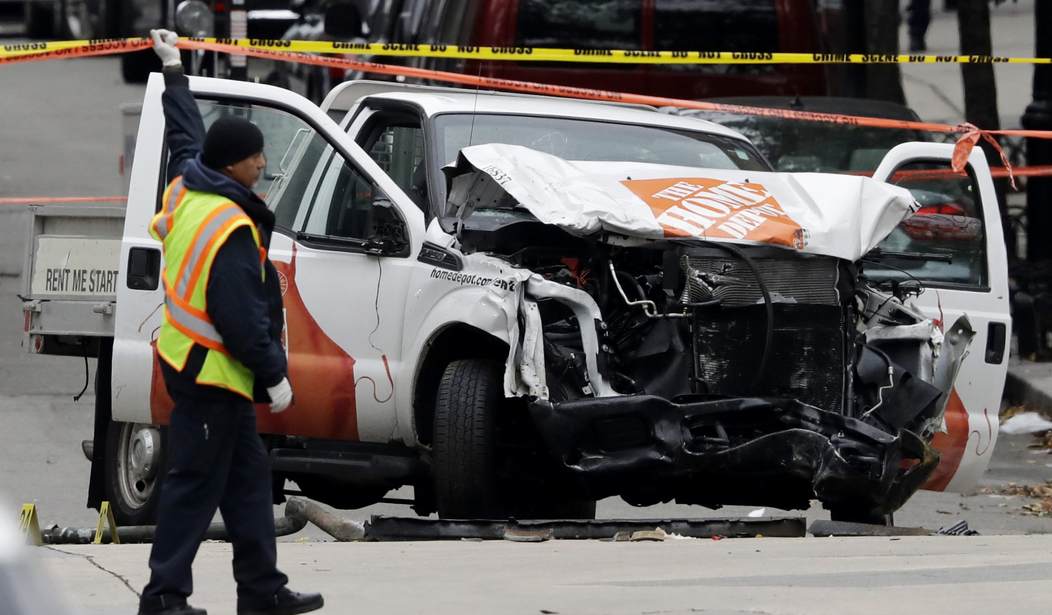Six months before this week’s Manhattan bike path attack, the Transportation Security Administration warned about the threat of “unsophisticated” vehicle ramming attacks and distributed guidance for rental counters, prepared in conjunction with the truck leasing industry, on spotting potential terrorists.
The security and awareness brochure prepared by the Truck Renting and Leasing Association (TRALA) and the Department of Homeland Security advised employees of companies that rent out trucks how to spot and report suspicious behavior, including customers “inquiring whether vehicles can be modified to handle heavier loads, create additional storage areas, increase fuel capacity, or vehicle speed.”
In an explicit vehicle-attack infographic in the May issue of their Rumiyah magazine, ISIS told would-be jihadis to rent a vehicle with a “slightly raised chassis and bumper,” a “double-wheeled, load-bearing truck” that is “large in size, heavy in weight” and is “fast in speed or rate of acceleration.”
That month, the TSA issued a report on the vehicle ramming threat that discussed reporting “any suspicions arising from the rental of large capacity vehicles in areas and within a proximate timeframe of parades and other celebratory gatherings, sporting events, entertainment venues, shopping centers, or other activities which place crowds near roads, streets or venues accessible by vehicles,” as well as “repeat renters who may appear to be ‘practicing’ their large vehicle skills in the time leading up to a nearby open event.”
The TRALA brochure distributed to companies said “insisting on renting a truck with a wooden rather than metal floor” could be a red flag, as well as using cash for large transactions or a customer being vague about references or the name used to rent the vehicle. The guide advised looking out for customers “wearing extraordinary attire such as heavy coats in the summertime” or who “seem to have attempted to disguise their appearance.”
Returned vehicles that “show physical evidence or produce an odor suggesting chemical or fertilizer transport” should be reported by employees, as well as those that “contain maps, blueprints, photos or drawings of buildings, roads, or other infrastructure or notes regarding the surveillance of such objects.”
“Always be observant of your surroundings whether at the rental counter, inside or outside the company’s facility, or in the areas near your company’s location,” the brochure states, and pay attention to “unauthorized persons loitering where rental vehicles are parked or serviced.”
TRALA said in a statement Thursday, two days after a rental truck was leased as a weapon to kill eight people in New York, that they’ve been working with law enforcement for many years on trying to prevent the use of rental trucks for nefarious aims.
“TRALA members stand in full support of federal, state and local law enforcement agencies and their efforts to prevent the use of trucks for illegal and/or harmful purposes,” said Jake Jacoby, TRALA president and CEO. “Further, we will continue to work with law enforcement agencies to prevent these types of acts in the future.”
In May, Jacoby said that “TRALA members realize they are often the first line of defense against a possible terror attack that could involve a commercial truck.”
In addition to coordinating with DHS on the “red flag” brochure, the trade association maintains a security committee and helps companies assess their internal security measures.
Sayfullo Saipov rented a flatbed pickup from Home Depot for 75 minutes — the lowest rental rate — in Passiac, N.J., an hour before using the vehicle to run over cyclists on the West Side bike path along the Hudson River in Manhattan. Neighbors told media that they had seen Saipov previously rent a similar truck in the weeks leading up to the attack, and that he drove the truck around accompanied by two friends.
“I did find it a little suspicious. You know, you got a truck box vehicle and you’re not doing anything with it,” neighbor Carlos Batista said. “You come back, same clothes, not even dirty or anything – it’s a little weird.”
Saipov, 29, was a truck driver by trade, but as a New Jersey resident he drove for Uber.









Join the conversation as a VIP Member